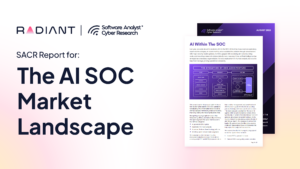
We’re excited to share that Radiant has been recognized by the Software Analyst Cyber Research (SACR) team as having the “most unique value proposition” in their newly released AI SOC Market Landscape 2025 report. In a fast-evolving market, the report highlights Radiant’s unmatched ability to triage any type of alert while delivering major cost savings through integrated log management, enabling customers to retain logs at a fraction of traditional SIEM costs.
It’s a powerful endorsement of our mission: to help security teams handle every alert with precision while cutting one of the SOC’s most significant cost drivers.
The SACR team frames the significance of this research with a critical question: “Is this the moment when security teams gain a lasting upper hand, or is AI simply another fleeting trend in the SOC?”
This report is one of the most comprehensive resources available for anyone evaluating AI-powered SOC platforms. It benchmarks 13 leading vendors, assesses architectural models, and, most importantly, provides a practical Operational Guide to AI SOC Adoption that every security leader should read before committing to a solution.
Why this report matters
The AI SOC Market Landscape report comes at a turning point for security operations. On average, SOC teams receive an unprecedented 960+ alerts per day, with some large enterprises receiving more than 3,000 daily alerts. Staffing shortages, alert fatigue, and blind spots in detection coverage have made “AI for Security” a top-three CISO priority.
This isn’t just a “trend” report. SACR’s methodology is rigorous, combining vendor interviews, real-world performance data, and a scoring framework that evaluates product maturity, capability depth, and quantitative performance. That makes it as much a buyer’s guide as it is an industry snapshot.
Radiant: The “Most Unique Value Proposition”
SACR singled out Radiant for a combination of full alert-type coverage and log cost optimization that’s rare in the industry:
Triage any alert
Whether it’s endpoint, network, cloud, identity, or other security use cases, Radiant automates triage across the entire stack, ensuring no alert is left uninvestigated.
Integrated log compression
Ingest logs and compress them with ~70% efficiency, cutting storage costs dramatically while preserving search and investigation capabilities.
Customer-controlled storage
Compressed logs are stored in the customer’s own environment, giving them sovereignty over their data without losing investigative functionality.
For some organizations, the cost savings alone justify the investment. For all, it’s a way to scale SOC operations without scaling headcount.
Adopting the right AI SOC platform: Evaluation guide
While recognition is gratifying, the real value for readers is SACR’s Operational Guide to AI SOC Adoption. The AI SOC space is evolving quickly, and not every platform is created equal. Here’s how SACR advises organizations to approach the evaluation and adoption process, plus our perspective on each step.
1. Define your AI security strategy
Before looking at vendors, define what problems you’re solving:
-
- Is alert fatigue your primary issue?
-
- Do you need faster investigations, reduced MTTR, or better coverage?
-
- What level of automation is acceptable?
Radiant’s take: Map SOC pain points to measurable metrics (e.g., % of alerts auto-closed vs. escalated, MTTR, etc.) so you can track ROI post-adoption.
2. Agree on the AI feature set
Decide which capabilities matter most to your environment:
-
- Automated triage and enrichment
-
- AI-assisted investigation and response
-
- Behavioral analytics and anomaly detection
-
- Threat intelligence integration
-
- Natural language querying
Radiant’s take: Prioritize features that address operational bottlenecks and cost drivers, such as combining automated alert triage with efficient log management.
3. Select an AI SOC vendor
Evaluate vendors on accuracy, explainability, and integration capabilities.
-
- Can they work with your SIEM, EDR, SOAR, and other existing tools?
-
- Do they meet your compliance and data governance needs?
-
- How quickly can they demonstrate value?
Radiant’s take: Ask for proof in the form of real-world case studies, performance metrics, and live demos in your environment.
4. Deploy the solution
Ensure smooth integration with existing workflows.
-
- Connect relevant telemetry sources
-
- Configure response automation (i.e., whether the platform should automatically remediate or keep a human analyst involved for response execution)
-
- Make sure the vendor provides hand-in-hand support
Radiant’s take: Fast, low-friction deployment is key to early wins, especially in complex environments.
5. Establish a trust period (1–2 Months)
Validate the AI’s performance before going fully autonomous.
-
- Monitor false positives
-
- Implement feedback loops
-
- Adjust automation scope as needed
Radiant’s take: This is where transparency and explainability matter most. Analysts need to understand why the AI made a decision.
6. Transition to full automation
Once trust is built, expand automation to handle routine or low-risk incidents, freeing analysts for higher-value work.
Radiant’s take: Gradual automation adoption ensures smooth change management and higher analyst confidence.
Automating the way to a modern SOC
The “AI SOC Market Landscape 2025” report makes it clear: AI is no longer optional in the modern SOC. But choosing the right platform isn’t just about features, it’s about fit, trust, and long-term value.
We’re proud to be recognized by SACR for delivering the most unique value proposition in the space, combining full-spectrum alert triage with game-changing log storage savings. And whether you choose Radiant or another platform, following a deliberate, metrics-driven adoption path will ensure AI becomes a lasting advantage, not a passing experiment.
To learn more about Radiant, book a demo today!
Back



